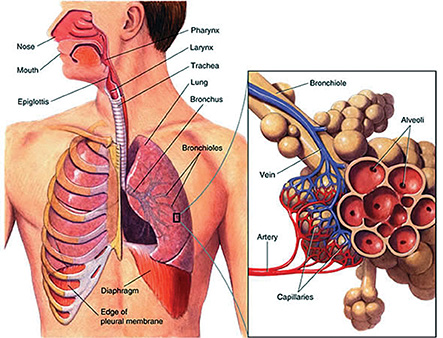According to a recent World Health Organization report, Asthma is the 17th leading cause of death amongst Nigerians, accounting for more deaths than even cancer of the cervix. The tragedy in that report is that, asthma deaths are largely preventable. Many asthmatics in the developed world live for decades without any major ‘asthmatic emergency episode’, and are more likely to die from old age than from asthma.
So what really is asthma, and what are the important things to know about the disease? The word ‘asthma’ is derived from the Greek word for ‘panting’, and naturally summons the image of a person struggling for air. The relationship between this disease -characterized by recurrent episodes of chest tightness, noisy breathing and panting- and its triggers such as exercise, pollen, and other contaminants in the air has been established at least 2000 years ago. In order to understand the disease, let us consider briefly the processes involved in breathing.
When we inhale air, the air passes through a series of large tubes to reach the lungs. Thereafter, the air moves through another set of increasingly smaller air conducting tubes called bronchi, and then bronchioles, before it eventually reaches the alveoli where gas exchange takes place, and our blood cells receive oxygen and give up carbon dioxide.
Asthma is a chronic –often lifelong- condition characterized by narrowing of the airways leading to the alveoli as a result of tightening of the normal smooth muscles which surround the bronchioles. These episodes of airway narrowing are often triggered by allergens, such as dust in the air, grass, smell of frying oil, and in some individuals, by exercise. They can lead to death if not reversed in minutes.
In normal people, when irritants are inhaled, the lung works to clear itself. However, in Asthmatics, the airways over-react, become narrow and cuts-off air supply to the alveoli.
 An asthma episode is characterized by dry coughing, wheezing –a whistling sound produced during inspiration, as air travels through narrowed airways, and shortness of breath or difficulty in breathing, as a result of the narrowed airways.
An asthma episode is characterized by dry coughing, wheezing –a whistling sound produced during inspiration, as air travels through narrowed airways, and shortness of breath or difficulty in breathing, as a result of the narrowed airways.
Although asthma can, and does lead to death, especially when severe and uncontrolled, the good news is that, medical advancements have made it easier to control, especially in well-motivated patients.
Asthma Control and Management
The first step in Asthma management is a proper diagnosis. One should not sit at home, surf the internet, self-diagnose and self-manage asthma. It is essential that every patient is taken to a hospital for evaluation and the institution of proper management.
Following diagnosis, the patient must now take stock of all the triggers of her asthmatic episodes such as dust mites, frying oil, smoke, etc., and work to control them. This first step of avoiding the common triggers of an asthmatic episode is crucial to Asthma management.
Most patients will need to follow up the initial diagnosis with regular monthly preventive checkup visits to their physicians, till the asthmatic episodes have reduced to a minimum.
A personal hand-held Peak Flow meter, which helps to keep track of air movement out of the lungs is advised.
Asthma medications are broadly divided into two classes: medications which provide fast, acute relief for emergencies, and medications for long term control. A patient needs both.
Long term medications include inhaled steroids, long acting beta agonists e.g salmeterol, cromolyn and even theophylline. They are usually taken daily. Inhaled steroids may, however, cause a mouth infection called ‘thrush’. It may also cause clouding of the eye lens and bone weakening. Therefore, it must be used carefully, and with a doctor’s prescription.
Acute relief drugs are usually in the form of inhalers containing a beta agonist, which can dilate airways, and should ideally not be used on more than two days in one week period. Anymore and the patient should see her doctor.
If both acute and long term medications fail, and symptoms persist, an asthmatic emergency is declared. The patient must be admitted in the hospital for proper management.
The management of asthma is one of the success stories of modern medicine. Patients who follow the management instructions given by their doctors, stay away from known triggers, and adhere to medication regime do very well.
—Dr. Luke
References Picture 1,© Goldiesroom.org
http://www.goldiesroom.org/Note Packets/13 Human Other/00 Human Other Systems–WHOLE.htm.
Picture2, ©Normal Breathing.com
http://www.goldiesroom.org/Note Packets/13 Human Other/00 Human Other Systems–WHOLE.htm

Well I believe that once asthma is well managed if the attack occurs, the person will recover. Also with the help of God when one avoids the things that trigger it the person will be healthy. Again prayerfully and totally hoping on God who is the healer the sickness will go.